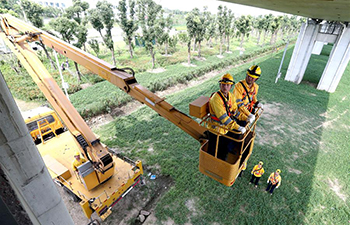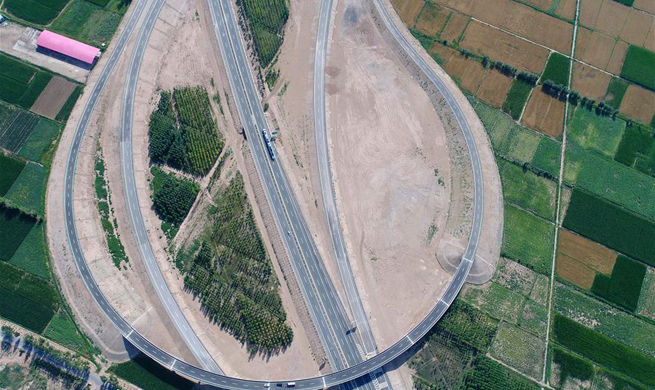URUMQI, July 15 (Xinhua) -- Twenty years have passed since the first officials from the central government and other provinces were dispatched to Xinjiang to assist local development.
More than 19,000 officials have worked in Xinjiang since the program was started by the Chinese government in 1997, which requires central ministries and 19 provinces and municipalities to support Xinjiang in building new infrastructure and boosting local development.
The assistance program set several records in terms of geographical area, the population involved and investment. The program has brought substantial changes for people in Xinjiang, which makes up one sixth of China's land area.
At the Sixth National Meeting on Pairing-Assistance to Xinjiang, held in Xinjiang from Sunday to Tuesday, China's top political advisor Yu Zhengsheng called for better education and continued efforts to help Xinjiang tackle poverty and implement employment-based poverty reduction projects.
IMPROVED LIVING STANDARDS
Wang Zhaolong from Beijing still remembers the first day he came to work in Hotan, a prefecture near the Taklimakan Desert in southern Xinjiang, five years ago.
"Donkeys were running on muddy narrow streets, traffic was chaotic, and even downtown residents lived in shabby homes," he recalled.
Beijing has been paired with Hotan under the program.
"As the capital, Beijing has rich resources and capital, while Hotan is one of the least developed regions in China. Beijing is obliged to support Hotan," Wang said.
Over the years, Wang has witnessed the changes in the city: four-lane streets have been paved to address traffic problems, green belts have been established to absorb sand and dust, and donkey carts have given way to cars.
Soon Hotan's 300,000 residents of different ethnic groups will have access to safe tap water of the same standard as Beijing. Upgraded water treatment plants are among the major infrastructure projects led by the Beijing municipal government this year.
Farmers and herders in Kizilsu Kirgiz Prefecture have moved into new homes with electricity, tap water, gas and toilets. Public squares, libraries and supermarkets are readily available in neighborhoods.
"I never thought I could one day live in such a nice home," said Memet Wruz, a herder. He used to live in a dilapidated mud house that hardly protected his family on rainy days.
According to the development and reform commission of Xinjiang, a total of 5,161 projects with a combined investment volume of over 58 billion yuan (8.5 billion U.S. dollars) were launched from 2011 to 2015. Of the investment, 74 percent were used to improve people's livelihood, and 85 percent went to counties and lower levels.
The commission reported that the housing conditions of more than 5 million people were improved, and more than 200,000 workers secured stable jobs, while 222 new schools were built and public service facilities were set up.
JOBS AT THE DOORSTEP
In order to raise local incomes, the 19 provinces and municipalities supporting Xinjiang opened small factories in villages to attract idle laborers, especially women reluctant to leave their hometowns.
Rizwangul Ghupur from a village in Yengisar County, Kashgar Prefecture started working at a ski glove factory near her home in 2014.
"I can earn more than 1,000 yuan a month without leaving the children and elderly behind," said the 36-year-old woman.
The ski glove company, based in east China's Shandong Province, entered the county three years ago, setting up a regional headquarters in the county seat and scores of small factories in villages or communities in southern Xinjiang.
Each factory can accommodate more than 100 workers from two to three villages, according to Xuanyuan Shuhao, a senior manager with the company.
Before getting the job, Rizwangul Ghupur and her husband picked cotton in Korla, more than 1,000 kilometers from Yengisar, making some 900 yuan for three months of work.
Many companies based in the 19 provinces and municipalities in the textile, new construction materials, photovoltaic power and e-commerce fields have invested in Xinjiang, bringing jobs and advanced managerial expertise.
DIVERSE CULTURAL LIFE
A talent show focusing on local people in Kashgar Prefecture became a hit soon after it launched on a local channel, with viewers exceeding 4 million.
"Each Saturday, every household in the village would watch the show in front of the TV set. I even heard the Kashgar television station was filled with participants signing up for the show," said Osman Memet, a local villager.
More than 600 people of various ethnic groups from Kashgar and neighboring prefectures, including soldiers, farmers, teachers and students, have told their stories and displayed their talent on the show.
A production team from Shanghai was behind the talent show, and the Shanghai municipal government sent 12 professionals to Kashgar during production.
Some 700 kilometers from Kashgar in Aksu Prefecture, a village auditorium has become a part of life for local residents. The 630-square-meter hall can accommodate 1,000 people.
"I enjoy dancing with my fellow villagers. The new place with all its advanced facilities offers a perfect stage for us," said Aishanjan Ibla.
Xinjiang is famous for its ethnic culture, music and dancing. Museums, libraries, media centers and theaters have blossomed in recent years in the "land of songs and dance."
Official data showed more than 300 cultural projects with a total investment of over 1.1 billion yuan were carried out from 2011 to 2015.

















